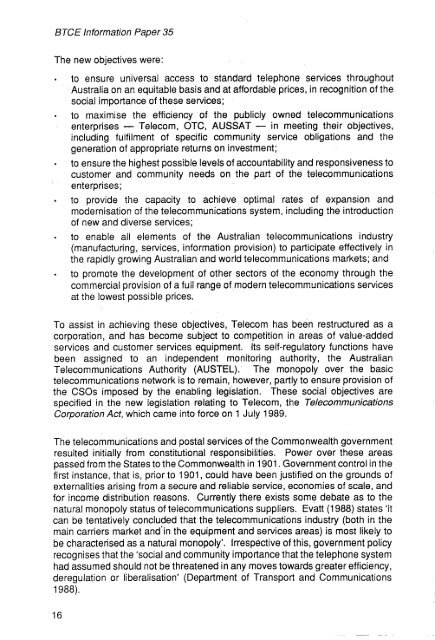PDF: 7881 KB - Bureau of Infrastructure, Transport and Regional ...
PDF: 7881 KB - Bureau of Infrastructure, Transport and Regional ...
PDF: 7881 KB - Bureau of Infrastructure, Transport and Regional ...
You also want an ePaper? Increase the reach of your titles
YUMPU automatically turns print PDFs into web optimized ePapers that Google loves.
BTCE lnformation Paper 35The new objectives were:to ensure universal access to st<strong>and</strong>ard telephone services throughoutAustralia on an equitable basis <strong>and</strong> at affordable prices, in recognition <strong>of</strong> thesocial importance <strong>of</strong> these services;to maximise the efficiency <strong>of</strong> the publicly owned telecommunicationsenterprises - Telecom, OTC, AUSSAT - in meeting their objectives,including fulfilment <strong>of</strong> specific community service obligations <strong>and</strong> thegeneration <strong>of</strong> appropriate returns on investment;to ensure the highest possible levels <strong>of</strong> accountability <strong>and</strong> responsiveness tocustomer <strong>and</strong> community needs on the part <strong>of</strong> the telecommunicationsenterprises;to provide the capacity to achieve optimal rates <strong>of</strong> expansion <strong>and</strong>modernisation <strong>of</strong> the telecommunications system, including the introduction<strong>of</strong> new <strong>and</strong> diverse services;to enable all elements <strong>of</strong> the Australian telecommunications industry(manufacturing, services, information provision) to participate effectively inthe rapidly growing Australian <strong>and</strong> world telecommunications markets; <strong>and</strong>to promote the development <strong>of</strong> other sectors <strong>of</strong> the economy through thecommercial provision <strong>of</strong> a full range <strong>of</strong> modern telecommunications servicesat the lowest possible prices.To assist in achieving these objectives, Telecom has been restructured as acorporation, <strong>and</strong> has become subject to competition in areas <strong>of</strong> value-addedservices <strong>and</strong> customer services equipment. Its self-regulatory functions havebeen assigned to an independent monitoring authority, the AustralianTelecommunications Authority (AUSTEL). The monopoly over the basictelecommunications network is to remain, however, partly to ensure provision <strong>of</strong>the CSOs imposed by the enabling legislation. These social objectives arespecified in the new legislation relating to Telecom, the TelecommunicationsCorporation Act, which came into force on 1 July 1989.The telecommunications <strong>and</strong> postal services <strong>of</strong> the Commonwealth governmentresulted initially from constitutional responsibilities. Power over these areaspassed from the States to the Commonwealth in 1901. Government control in thefirst instance, that is, prior to 1901, could have been justified on the grounds <strong>of</strong>externalities arising from a secure <strong>and</strong> reliable service, economies <strong>of</strong> scale, <strong>and</strong>for income distribution reasons. Currently there exists some debate as to thenatural monopoly status <strong>of</strong> telecommunications suppliers. Evan (1988) states ‘itcan be tentatively concluded that the telecommunications industry (both in themain carriers market <strong>and</strong>’in the equipment <strong>and</strong> services areas) is most likely tobe characterised as a natural monopoly’. Irrespective <strong>of</strong> this, government policyrecognises that the ‘social <strong>and</strong> community importance that the telephone systemhad assumed should not be threatened in any moves towards greater efficiency,deregulation or liberalisation’ (Department <strong>of</strong> <strong>Transport</strong> <strong>and</strong> Communications1988).16
















